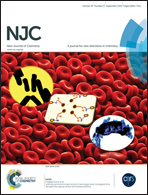Fluorescein isothiocyanate embedded silica spheres in gadolinium carbonate shells as novel magnetic resonance imaging and fluorescence bi-modal contrast agents†
Abstract
In this study, four bi-modal core-shelled contrast agents of SiO2(FITC)@Gd2O(CO3)2·H2O with varying shell thicknesses but the same cores have been prepared via a two-step wet chemistry method. The four samples were quite close to sphericity and their averaged diameters were 127, 140, 148.7 and 174.0 nm. The composition of their shells was also examined. As the shell thickness increased, the fluorescence intensity halved but the longitudinal relaxivity remained high (28, 29, 27, 24 mM−1 s−1). The measured relaxivities of the samples were more than 5.8 times higher than the relaxivity of Gd-DTPA-BMA in a 0.55 T MR (magnetic resonance) system. The levels of cytotoxicity were tested on four cell lines (293, HeLa, HFL1, MCF-7) and the results indicated that the samples were safe. The intracellular fluorescence in HeLa cells was clearly observed using laser confocal microscopy. These results showed that this material had potential for application in MR-fluorescence bi-modal imaging.


 Please wait while we load your content...
Please wait while we load your content...